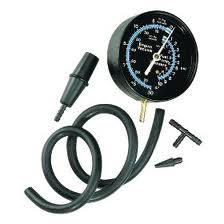Using a Vacuum Gauge to Check Engine Performance
This is defiantly old school but as I’ve stated over and over in this article modern engines function in the same way they always have. Your engine is an air compressor. When it’s working correctly, it’s smooth and wonderful. If it’s not working correctly it can cause performance issues. A vacuum gauge is an inexpensive tool that can tell you quite a bit about how your engine is performing. If you hook a Using a Vacuum Gauge to Check Engine Performance up to an intake vacuum source, it can tell you a lot about your engine’s health. On a good running engine you should see engine vacuum between 17-21inhg at idle. The needle should hold steady and not shake about. If it’s low or shakes, then you have a performance issue somewhere. I don’t want to get into all the specifics of what problems are indicated by the vacuum readings you get, but I do want to make you aware of this tool and it’s capabilities. Even if you just hooked up the gauge and observed the reading you would have a pretty good idea of how your engine is performing. At some point I may do an article just on using a vacuum gauge. For now you can use this next test to see if you have and exhaust restriction. It’s a pretty cool test, I think you’ll like it.
Video Title: Using a Vacuum Gauge to Check Engine Performance – Solving Automotive Performance Issues – EricTheCarGuy Video Description: In this Article, Using a Vacuum Gauge to Check Engine Performance, we look at how using a Vacuum Gauge to Check Engine Performance operation can help find what can affect engine Automotive Performance. Thumbnail: http://www.ericthecarguy.com/images/faq_buttons/Large_FAQ_Images/Performance-and-Driveability-icon-1200.jpg
 Our Address
Our Address



